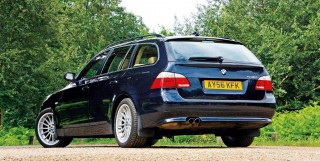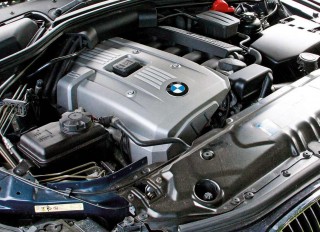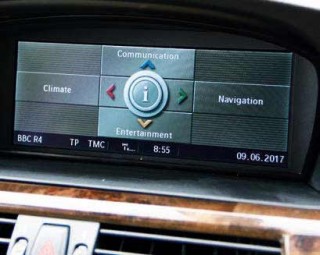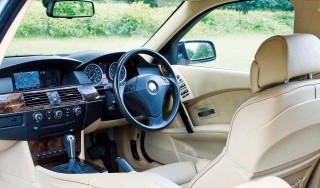If you want the ultimate performance estate you’d buy an E61 M5 Touring. If you want a very quick estate then, maybe, the V8-engined 545i or 550i would fit the bill. But spend a moment or two considering the likely running costs associated with these exotic machines – especially the M5 – and you might decide that your future Touring doesn’t need to be quite that rapid after all! So, being rather more realistic about things, you’re left with a choice between six-cylinder petrol- or diesel-powered models and, as the ‘oil-burners’ are being somewhat demonised nowadays, my advice is to have a look at the 530i Touring. After all, six-and-a-half seconds to 62mph isn’t too tardy, even these days, especially for an executive load-lugger.
BASIC SPECIFICATION
The 530i arrived in 2005, was available in either SE or Sport trim and featured the 258hp, N52 straight-six engine. It could be ordered with either the six-speed manual or a six-speed auto, with the latter being the more popular choice. Standard kit was acceptable without being overly generous, but most first owners typically added niceties such as leather upholstery and satellite navigation from the extensive options list.

The engine was upgraded when the 5 Series went through its facelift in 2007; it received the 272hp N53 unit, resulting in slightly improved performance plus better economy and emissions. There were a few interior revisions, too, as well as changes to the front and rear lights, but none of this produced a seismic difference between the pre- and post-facelift cars.
The good news for buyers now is that prices start at around £5,000 for a decent example. At the top end you’ll struggle to find one for more than £9,000. As always, buy on condition and carefully check the history for signs that the car has been well looked after, and you shouldn’t go too far wrong.
BODY BEAUTIFUL?
Beauty is, they say, in the eye of the beholder, and while a 530i sitting on the wrong wheels and painted one of those E61-era colours that haven’t aged very well can look somewhat dowdy, a Carbon black M Sport-kitted example still looks fresh and clean.

Generally speaking, a 530i Touring is a pretty tough old boot, but there is a number of things you should be checking for during a pre-purchase inspection. The first thing on your list should be the bodywork. Now, while BMW had pretty much got the rust thing sorted out by the time the E61 came along, this doesn’t mean that you shouldn’t spend time assessing the car carefully.
Check panel gaps and colour match between panels, and have a quick poke about underneath as it’s likely that, if there’s anything wrong with an E61, it’ll be on the underside, either as a result of damage or the early signs of corrosion.
Examine the top of the rear bumper as this can easily become damaged by loads being dragged in and out of the boot.
Inspect the headlights for damage, especially if they’re xenons or the rare adaptive xenons, as they’re frighteningly expensive to replace – over £1,000 each for the adaptive units. If the car’s fitted with the panoramic sunroof, take the time to make sure it works smoothly as, if not used regularly, these have a tendency to get stiff.

Drain holes for the sunroof can also become blocked if they’re not checked regularly, so make sure the carpet isn’t wet inside the car, too. While on the subject of water ingress, it’s also worth checking whether or not wet carpets in an E61 are the result of blocked drain holes in the scuttle area. If these get clogged, water will rise up and come over the top of the scuttle, causing the damp carpet but, more significantly, giving some ECUs an unwanted water bath.
WHEEL OPTIONS
While you’re inspecting the outside of the car, you might as well check the wheels and tyres. The E61’s alloys don’t seem to be as affected as contemporary 3 Series models, when it comes to crack damage but, do examine them for kerb rash and any obvious defects. You occasionally see a 530i on 16-inch wheels, but the majority are fitted with either 17s or 18s, with the larger option being standard on the Sport/M Sport models.
From new, all models came with runflat tyres and, while they received a lot of stick back in the day for their ride quality (or should we say, lack of), the latest generation of run-flats is much better. So you may like to stick with these for the peace of mind they give.
But if you do decide to fit standard rubber (and many owners have), then you might want to invest in a space-saver spare which will fit under the boot floor. For 18in wheels, the Touring ran an all square set-up, and non-run-flat tyres will cost about £120 each for a quality brand. Run-flats are more expensive, at £150 or so each.
While you’re gazing lovingly at the wheels, spare a thought for the brakes sitting behind them, and try to get a feel for the condition of the pads and discs. They’re not ruinously expensive from BMW – front pads are £169 fitted (rears £165) – but if new discs are required as well, you’ll be looking at £399 for the fronts and £335 at the back. Other than that, you shouldn’t really have any concerns with the brakes on a 530i.
Scuffed alloys are a common occurrence on cars of this age but, assuming the damage isn’t too severe, a decent refurb is affordable.
As the ‘oil-burners’ are being somewhat demonized nowadays, my advice is to have a look at the 530i.
ENGINE OPTIONS
One of the main reasons for choosing the 530i over one of the diesels is for the silkysmooth straight-six engine, so you’ll want to make sure it’s in fine fettle. You have a choice of two units in a 530i Touring; the M54 that was originally fitted to the E60-generation had been phased-out by the time the 530i hit the UK in early 2005. Thus, you’ll be either looking at the 258hp N52 or the 272hp N53. Both are pretty decent motors, but do have a couple of Achilles’ heels.

With the BMW N52, you can experience wear in the camshaft housing which, when bad enough, will allow oil under pressure from the Vanos unit, to escape. Repair involves expensive head work and, while this problem does seem to strike pretty randomly, the best thing you can do is get the oil and filter changed annually, or every 7,000-8,000 miles. Condition Based Servicing really isn’t all it’s cracked up to be, and any private owner would be well advised to ignore it as far as oil change intervals are concerned.
The other problem you’re likely to encounter with the N52 ‘six is a failed electric water pump. These are expensive – about £850, fitted – so it’s well worth checking the history to see if it’s been replaced in the past. Unfortunately, with these it’s pretty much a case of when, not if, it’ll fail.
So, would the direct-injection BMW N53 engine be a better bet in your E61 530i? It’s certainly more powerful, returns more miles to the gallon and has lower emissions (and hence a lower VED rate), but this engine has its problems, too. The biggest issue centres on the fuel-injectors. You’re looking at £200 each, plus fitting, plus coding, and you may also need to replace a NoX sensor as well. Running faults with these engines generally seem to come down to faulty injectors so again, check its history to see if any have been replaced in the past.
The E61, despite its impressive, load-lugging credentials, can still put a smile on your face down a twisty road.
| ENGINE: | N52 straight-six, 24-valve | N53 straight-six, 24-valve |
| CAPACITY: | 2,996cc | 2,996cc |
| MAX POWER: | 258hp @ 6,600rpm | 272hp @ 6,700rpm |
| MAX TORQUE: | 221lb ft @ 2,500-4,000rpm | 236lb ft @ 2,750-3,000rpm |
| 0-62MPH: | 6.6 secs | 6.5 secs (6.8) |
| TOP SPEED: | 155mph (155) | 155mph (155) |
| ECONOMY: | 31.0mpg (30.1) | 34.8mpg (35.7) |
| EMISSIONS: | 222g/km (230) | 191g/km (187) |
| (Figures in brackets refer to six-speed, auto models) | ||
CHOICE OF SIXES
As far as the transmission is concerned, there’s a choice of a six-speed manual that’s more or less bulletproof, a six-speed auto that’s pretty good, and a six-speed SSG which was fortunately a rare option and is best avoided.

The manual is good, although, as it’s a sealed-for-life unit, some fresh oil in it as the mileage gets higher won’t go amiss. Clutches are pretty durable and not too pricy to replace, while dual-mass flywheels don’t give trouble.
However, the six-speed auto can be a little more problematic and, according to BMW, these are also sealed-for-life units. They can be prone to an oil leak or two, and my advice would be to treat the box to a fluid overhaul every 60,000-70,000 miles.
Jerky change quality can be put down to software problems, low oil level or a faulty mechatronics unit. Thankfully, this latter item tends not to fail too often, as a rebuilt unit costs about £1,000. Differentials and driveshafts rarely give trouble, but listen out for any untoward clonks from the rear, when taking-up drive.
SOLID SUSPENSION
The suspension setup on the E61 isn’t too bad, but there are a couple of known weak points. Up front, you’ll find the expected springs and dampers and these don’t give too much trouble, apart from the occasional age-/mileage-related replacement. The various BMW parts specialists will be happy to sell you OE-spec replacements at a reasonable price. Front suspension bushes, arms and ball joints are fairly tough, but if the car you’re looking at hasn’t had some of them replaced yet, then budget for a bit of a refresh in this department.
It’s at the rear that you’re more likely to experience some trouble, mainly with the self-levelling airbags that the E61 uses instead of rear springs. It’s not that they’re intrinsically unreliable, it’s more that after a period of time, the bags can split and require replacement.
They cost from £150 or so from the aftermarket; considerably more from BMW. Occasionally, the compressor for the air springs will fail and you’ll be looking at about £400 to replace it from an independent, but double that from BMW.
ELECTRICAL ISSUES
While the E61’s interior wasn’t perhaps quite as durable as an E39’s, it’ll still last pretty well if it’s been looked after. Look out for peeling plastics on and around switches and on the steering wheel. Otherwise, it’s a case of checking that everything works, from the air conditioning to the windows to the electric seats… and don’t forget the iDrive, either.

If the car you’re considering is fitted with sat nav, take care to check that it works properly, but don’t expect wonderful functionality or usablility – the game has moved on massively since the E61 was designed, and the iDrive is slow and clonky to use. At least there’s a good spot for your smart phone up by the iDrive screen when you’re using its navigation app!
There are a couple of electrical issues that are unique to the Touring, and these are both related to the tailgate. First up is the diversity antenna, that’s located underneath the section of trim that also contains the high-level brake light. This acts both as an aerial for the radio, and a receiver for the signals coming from the remote control key fob. So, if there’s a fault with radio reception, or the remote central locking not working, it’s almost certain to be the diversity antenna. Over time, water leaks through the seal and eventually they give up the ghost, but fortunately they’re not hugely expensive.
The second issue relates to the tailgate wiring, where it runs in channels in the boot lid hinges. This also affected the E39, so it’s a little irritating that BMW didn’t make a better job of it in the E61 – the wires crack and break within the hinge channels, basically because space is very tight in there, and BMW wasn’t overly generous with the length of the wires, either.
A bit of poor design really, and any faults relating to the tailgate lighting, inoperative heated rear window or the split tailgate not working, will almost certainly be down to a break in the wiring loom. Repairs aren’t that difficult, just time-consuming and a little fiddly.
FINAL WORDS
While the BMW E61 530i isn’t the perfect car, there’s certainly much to commend it. It’s still reasonably rapid for a large estate and it really does handle very well. Provided you buy wisely, there’s no reason why running costs should be too high, although some may baulk at the £520 VED rate for an automatic, pre-facelift machine. However, manual or post-LCI models are more palatable, ranging from £240 to £305.
But for a car with a quality feel, that can swallow a load of passengers plus their luggage and remains more than capable of entertaining its driver on back roads, it still takes a lot of beating.
“The good news for buyers now is that prices start at around the £5,000 mark, for a decent example”
“As the ‘oil-burners’ are being somewhat demonised nowadays, my advice is to have a look at the 530i”

A useful, opening tailgate window adds versatility. Hinge-routed wiring can cause electrical issues with the rear window heater. As far as bodywork is concerned, the E61 5 Series is pretty durable and visible rust problems are rare. However, rust-causing damage can occur underneath. The E61’s interior is pleasant, comfortable and generally durable. Avoid cars fitted with the troublesome, six-speed, SSG transmission. The old-school, analogue dials are clear and easy to read. By modern standards, the iDrive interface in this car is somewhat cumbersome to use, but give it a little time and it’ll do its job.





